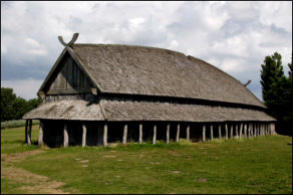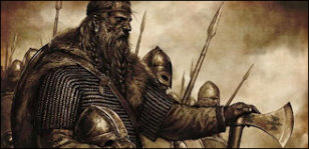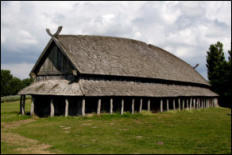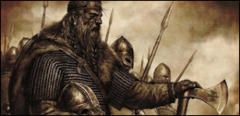



Norse life
Warrior Culture
The social and religious beliefs of the Norse placed death in battle as the highest state that a man can achieve. Early Norse were groups of warriors, each headed by a warlord - there were no “national kings”. Warriors attached themselves to the “lord” whom they felt was the best warrior leader in their vicinity. The warlord’s position was acquired through respect and was not an inherited one. There were regional chieftains or petty kings but their roles were separate from the warlords. Members of the warlord’s retinue included: ▪ drang, a young warrior ▪ thegn, a mature warrior ▪ skeppare, captain of a chiefly vessel ▪ himthiki, housekarls or the lowest rank of elite soldiers ▪ folc, the population of a settlement Power struggles among Scandinavian warlords and petty kings developed in the early 9th century, and these conflicts resulted in the creation of dynastic regional kings and a secondary elite class which competed directly with the warlords. The first national king of Norway was Harald Fairhair who was believed to reign from 872 to 930 AD.King
The title of king or earl could be inherited, or it could be conferred by prominent supporters or the leader of military forces. Kings were not viewed as sacred, or special. Instead, they were viewed as exceptionally able and imperious men. The king was expected to be generous not only with food and drink, but with clothes, weapons and other gifts. He was expected to maintain his own and his followers' honour against outsiders. He had to lead and was expected to be a strong fighter, daring, crafty, and hard, since he fought hand to hand beside his men. He had to be a good public speaker, cheerful and inspirational, able to inspire his men and maintain a high level of morale. Below the king, three social classes existed in Norse society. The classes were nowhere near as rigid as they were in other parts of Europe at the time. Mechanisms existed such that a person could move himself from one class to another.Jarl (Earl)
Jarls were effectively local “kings”. They were distinguished by their wealth measured in terms of followers, treasure, ships, and estates. The eldest son of the jarl was on the fast track to becoming the next jarl. The power of a jarl depended upon the goodwill of his supporters. The jarl's essential task was to uphold the security, prosperity, and honour of his followers.Karl
The vast majority of Norsemen belonged to the middle class, the karls. These people were freemen and land owners. They were the farmers, the smiths; the artisans of the society. Families of karls usually lived in clusters of two or more buildings, typically longhouses supplemented by barns and workshops. It was common for karls to go a- viking in the summer while waiting for their crops to mature. By gaining enough fame and wealth, a karl could become a jarl.Thrall
The third class were the Thralls. These included the slaves (usually booty from a raid) and bondsmen. If a Norseman of any class could not pay his debts, he was obliged to become a bondsman and to work for another man until the debt was paid. Slaves generally worked alongside hired workers on family farms, although the harder and less desirable work frequently fell on the backs of the slaves. Slavery existed throughout all the Norse lands in the Viking age, ending during the 12th and 13th centuries.Variations
The actual social structure, not surprisingly, was more complex than this simple explanation would indicate. There were many gradations in position, as well as substantial variations in class structure from one Norse land to another. Poets were held in similar stature to royalty. Norse culture was oral, rather than written. Poets were the means by which the culture was passed from one generation to the next. Accordingly, they were held in high esteem. Merchants, although they might not own land, were also held in similar regard to the land owners. Outlaws were outside the structure entirely. It was either by their own choice, or by punishment imposed by law. In this category were also: beggars and tramps, magicians, witches, and seeresses. An outlaw was little better than an animal, who could be killed without penalty, and who was treated, according to Danish law, "as if he were dead".

© Walter Jardine 2016


Novel





Norse life
Warrior Culture
The social and religious beliefs of the Norse placed death in battle as the highest state that a man can achieve. Early Norse were groups of warriors, each headed by a warlord - there were no “national kings”. Warriors attached themselves to the “lord” whom they felt was the best warrior leader in their vicinity. The warlord’s position was acquired through respect and was not an inherited one. There were regional chieftains or petty kings but their roles were separate from the warlords. Members of the warlord’s retinue included: ▪ drang, a young warrior ▪ thegn, a mature warrior ▪ skeppare, captain of a chiefly vessel ▪ himthiki, housekarls or the lowest rank of elite soldiers ▪ folc, the population of a settlement Power struggles among Scandinavian warlords and petty kings developed in the early 9th century, and these conflicts resulted in the creation of dynastic regional kings and a secondary elite class which competed directly with the warlords. The first national king of Norway was Harald Fairhair who was believed to reign from 872 to 930 AD.King
The title of king or earl could be inherited, or it could be conferred by prominent supporters or the leader of military forces. Kings were not viewed as sacred, or special. Instead, they were viewed as exceptionally able and imperious men. The king was expected to be generous not only with food and drink, but with clothes, weapons and other gifts. He was expected to maintain his own and his followers' honour against outsiders. He had to lead and was expected to be a strong fighter, daring, crafty, and hard, since he fought hand to hand beside his men. He had to be a good public speaker, cheerful and inspirational, able to inspire his men and maintain a high level of morale. Below the king, three social classes existed in Norse society. The classes were nowhere near as rigid as they were in other parts of Europe at the time. Mechanisms existed such that a person could move himself from one class to another.Jarl (Earl)
Jarls were effectively local “kings”. They were distinguished by their wealth measured in terms of followers, treasure, ships, and estates. The eldest son of the jarl was on the fast track to becoming the next jarl. The power of a jarl depended upon the goodwill of his supporters. The jarl's essential task was to uphold the security, prosperity, and honour of his followers.Karl
The vast majority of Norsemen belonged to the middle class, the karls. These people were freemen and land owners. They were the farmers, the smiths; the artisans of the society. Families of karls usually lived in clusters of two or more buildings, typically longhouses supplemented by barns and workshops. It was common for karls to go a-viking in the summer while waiting for their crops to mature. By gaining enough fame and wealth, a karl could become a jarl.Thrall
The third class were the Thralls. These included the slaves (usually booty from a raid) and bondsmen. If a Norseman of any class could not pay his debts, he was obliged to become a bondsman and to work for another man until the debt was paid. Slaves generally worked alongside hired workers on family farms, although the harder and less desirable work frequently fell on the backs of the slaves. Slavery existed throughout all the Norse lands in the Viking age, ending during the 12th and 13th centuries.Variations
The actual social structure, not surprisingly, was more complex than this simple explanation would indicate. There were many gradations in position, as well as substantial variations in class structure from one Norse land to another. Poets were held in similar stature to royalty. Norse culture was oral, rather than written. Poets were the means by which the culture was passed from one generation to the next. Accordingly, they were held in high esteem. Merchants, although they might not own land, were also held in similar regard to the land owners. Outlaws were outside the structure entirely. It was either by their own choice, or by punishment imposed by law. In this category were also: beggars and tramps, magicians, witches, and seeresses. An outlaw was little better than an animal, who could be killed without penalty, and who was treated, according to Danish law, "as if he were dead".





















